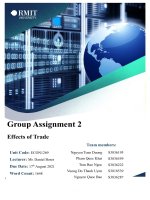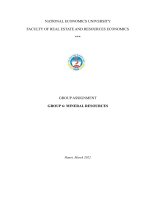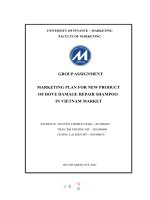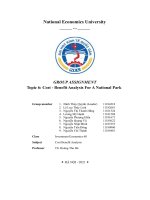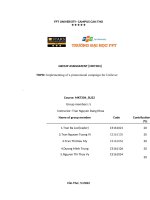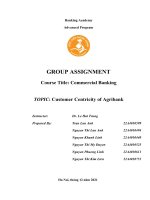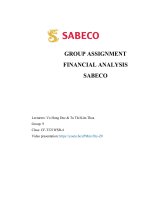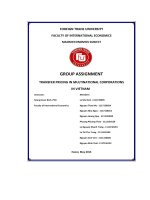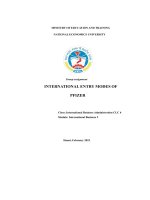tiểu luận group assignment topic financial analysis of nike
Bạn đang xem bản rút gọn của tài liệu. Xem và tải ngay bản đầy đủ của tài liệu tại đây (4.6 MB, 45 trang )
<span class="text_page_counter">Trang 1</span><div class="page_container" data-page="1">
<b>CORPORATE FINANCE</b>
<b>GROUP ASSIGNMENT</b>
<b>FINANCIAL ANALYSIS OF NIKE</b>
Professor : Do Khac TrungClass : 47K01.4Group : 7
Members : Truong Gia LinhHo Hoang NhiNguyen Thi Ngoc OanhNguyen Thi Phuong Thao
<i>Da Nang, December 6 , 2023<small>th</small></i>
</div><span class="text_page_counter">Trang 2</span><div class="page_container" data-page="2"><b>3.Cash Flow Statement... 10</b>
<b>III. FINANCIAL ANALYSIS... 12</b>
</div><span class="text_page_counter">Trang 3</span><div class="page_container" data-page="3">2.1. Total Debt Ratio...14
2.2. Debt/equity Ratio and Equity Multiplier...16
2.3. Long-term Debt to Equity Ratio...17
<b>3.TURNOVER RATIOS...19</b>
3.1. Inventory Turnover...19
3.2. Receivables Turnover...21
3.3. Fixed Asset Turnover...23
3.4. Total Asset Turnover...24
<b>5.MARKET VALUE RATIOS... 31</b>
5.1. Price Earnings Ratio...31
5.2. Market To Book Ratio...33
<b>6.SHORT-TERM FINANCIAL POLICY...34</b>
<b>CONCLUSION... 36</b>
<b>REFERENCES... 38</b>
ii
</div><span class="text_page_counter">Trang 4</span><div class="page_container" data-page="4"><i>Corporate Finance - Group 7 – 47K01.4</i>
<b>LIST OF TABLES</b>
Table 1. Balance Sheet of Nike 2018-2022...9
Table 2. Income Statement of Nike 2018-2022...10
Table 3. Cash Flow Statement 2018-2022...12
<b> LIST OF FIGURES</b>
Figure 1. Real GDP growth of the world [6]...2Figure 2. Inflation rate, average consumer prices of the world [6]...3
Figure 3. Revenue (Dollars in millions) in 2022...6
Figure 4. Gross Margin in 2022 and 2021...6
Figure 5. Sales by product divisions...7
Figure 6. Current Ratios & Quick Ratio of Nike from 2018 to 2022...12
Figure 7. Total Debt Ratio of Nike from 2018 to 2022...15
Figure 8. Debt/equity Ratio and Equity multiplier of Nike from 2018 to 2022...17
Figure 9. Long-term Debt to Equity Ratio of Nike from 2018 to 2022...18
Figure 10. Inventory Turnover of Nike between 2018 and 2022...20
Figure 11. Days' sales in Inventory of Nike from 2018 to 2022...21
Figure 12. Receivables Turnover of Nike from 2018 to 2022...22
Figure 13. Days' sales in Receivables of Nike from 2018 to 2022...23
Figure 14. Fixed Asset Turnover of Nike from 2018 to 2022...24
Figure 15. Total Asset Turnover of Nike from 2018 to 2022...25
Figure 16. Profit Margin of Nike from 2018 to 2022...26
Figure 17. Return In Investment of Nike from 2018 to 2022...27
Figure 18. Return On Asset (ROA) & Return On Equity (ROE) from 2018 to 2022...28
Figure 19. Return On Assets of Nike and Adidas from 2021 to 2022...30
Figure 20. Return On Equity (ROE) of Nike and Adidas from 2021 to 2022...30
Figure 21. Price/earning ratio and Market - to - book ratio of Nike from 2018 to2022...32
<b>Too long to read onyour phone? Save to</b>
read later on yourcomputer
Save to a Studylist
</div><span class="text_page_counter">Trang 5</span><div class="page_container" data-page="5">Nike is one of the famous brands in the sports shoe industry. It is an Americanmultinational corporation engaged in the design, development, manufacture, marketingand worldwide sale of footwear, apparel, equipment, accessories and services. Thecompany is headquartered near Beaverton, Oregon, in the Portland metropolitan area. Itis the world's largest supplier of sports shoes and apparel, as well as a major sportsequipment manufacturer, with revenue exceeding US $46 billion in fiscal 2022. Beloware the contents overview of the sports industry in the world today, and focus on carefullyanalyzing and clarifying Nike's financial indicators to see the level of development andperformance of the company over a 5-year period (2018 - 2022) recently.
1
</div><span class="text_page_counter">Trang 6</span><div class="page_container" data-page="6"><b>I.BUSINESS DESCRIPTION</b>
The growth of Nike - A multinational corporation with operations in 160 countries- is influenced by many factors in the macroeconomic environment.
<b>Economic growth and world trade growth trends</b>
The IMF's World Economic Outlook Report updated in January 2023 stated thatglobal economic growth is forecast to reach 2.9% in 2023 (<i><b>Figure 1). </b></i>Compared to theforecast in October 2022, the growth forecast in The world's 2023 forecast is 0.2percentage points higher due to a larger-than-expected recovery in many majoreconomies around the world. Consumer confidence has begun to improve and businessconfidence indicators have gradually stabilized in major G20 economies.
Trade growth slows amid continuing weakness in supply chains, falling demandfor consumer goods and prolonged conflict in Ukraine. The economic outlook for 2023remains uncertain as it is affected by the pace and sequence of monetary policytightening, developments in the conflict in Ukraine and other geopolitical tensions thatthreaten disruption of the global supply chain segment.
<i>Figure 1. Real GDP growth of the world [6]</i>
<b>The rising inflation has reduced consumer spending. </b>
However, growth forecasts for 2023 remain low, reflecting central banks raisinginterest rates to cope with inflation, especially in developed economies, as well as theimpact of the conflict between Russia and Ukraine. The IMF believes that global inflationhas peaked, and it is expected that the 2023 consumer price index of 84% of countrieswill be lower than in 2022. The global average annual inflation is expected to decrease
</div><span class="text_page_counter">Trang 7</span><div class="page_container" data-page="7">from 8.8 % in 2022 to 6.6% in 2023 <i>(Figure 2).</i> In North America - the biggest market ofNike, persistent inflation is one of the main causes of reduced purchasing power.
<i>Figure 2. Inflation rate, average consumer prices of the world [6]</i>
<b>The global labour market outlook for 2023 has not yet recovered to pandemic levels.</b>
pre-According to the International Labor Organization (ILO), by the end of 2022, therecovery process after the Covid-19 crisis is still incomplete and uneven around theworld. Global employment is forecast to increase by 1.0% in 2023 (adjusted down 0.5percentage points compared to the forecast in January 2022), a significant decreasecompared to the 2.3% employment growth rate 2022.
The global athletic footwear market, valued at USD 127.3 billion in 2021, is set togrow steadily at a CAGR of 4.9% from 2022 to 2030. This growth is driven by risingawareness of the health benefits associated with sports and fitness activities. Factors likethe booming global e-commerce sector and increasing disposable income levels alsocontribute significantly. Young individuals are adopting healthier lifestyles, activelyengaging in sports, which not only reduces the risk of chronic conditions but also foster'smarket demand.
However, the U.S athletic footwear industry faced challenges due to Covid-19.Nike, Brand Jordan, and Converse witnessed significant declines in sales, as did othermajor brands like Adidas, Skechers, ASICS, Vans, Under Armour, and Fila.
Despite the industry's growth, environmental concerns pose a significant obstacle.Government initiatives against pollution affect the market, with athletic footwear
3
</div><span class="text_page_counter">Trang 8</span><div class="page_container" data-page="8">contributing substantially to river and environmental pollution. Notably, major brandslike Puma, Nike, and Adidas were criticized by Greenpeace, particularly Puma forcollaborating with polluting suppliers in China.
Key market players, including Nike, Adidas, Skechers, and New Balance, focus oninnovative technologies. For example, Adidas introduced Forged Mesh, a single-layerupper shoe designed using ARAMIS motion capture technology. This innovationprovides flexibility and ankle support. Adidas also patented other technologies likeAdaptive Traxion, Boost, Bounce, Climachill, Primeknit, and Stableframe to enhancesports shoe stability and comfort.
<b>2.2.End-user Insights</b>
The men's segment, with a revenue share exceeding 55.0% in 2021, will maintainits dominance until 2030. Women's footwear is gaining ground due to increasing femaleinterest in sports, especially in previously untapped markets. Developed nations have ahigher proportion of women athletes in major events compared to developing countries.Moreover, awareness about women's fitness is notably higher in advanced nations than indeveloping ones. However, there's a shift in developing countries due to governmentefforts encouraging women's active participation in sports and fitness. This trend isexpected to significantly increase sales of women's athletic footwear in emergingmarkets.
<b>2.3.Regional Insights</b>
Asia Pacific, with a revenue share surpassing 35.0% in 2021, maintained marketdominance and is set to continue leading throughout the forecast period. This region isanticipated to experience the highest growth rate, propelled by rising disposable incomesand widespread e-commerce adoption. The growing enthusiasm for sports events like theAsian Games, ICC Cricket World Cup, and ACC Asia Cup further fuels the demand forathletic footwear in the Asia Pacific region.
<b>2.4.Key Companies & Market Share Insights</b>
The market includes both international and domestic participants. Key marketplayers focus on strategies such as innovation and new product launches to enhance theirportfolio offering in the market. In March 2021, a Kanye west inspired line of sneakerswas launched by Adidas as the Yeezy series 450 as a sequel to Yeezy 350 series. In June2021, Kiko Kostadinov’s ASICS GEL-Quantum Levitrack was launched, with a GELmidsole. Some prominent players in the global athletic footwear market include: Adidas
</div><span class="text_page_counter">Trang 9</span><div class="page_container" data-page="9">AG, ASICS Corporation, Fila Inc, Under Armour, Inc., Lotto Sport Italia S.p.A, NewBalance Athletics, Inc., Vans, Inc., Nike, Inc., Puma SE, Reebok International Ltd.
Established in the year 1964, Nike is an American multinational corporation bestknown for its footwear and sportswear. The company's global headquarters are locatednear Beaverton, Oregon, in the Portland metropolitan area (USA). Nike, together with itssubsidiaries, the Converse and Jordan brands, designs, develops, markets, and sellsathletic footwear, apparel, equipment, and accessories worldwide. Nike Inc. has enjoyeddecent growth in the industry over the past few decades while maintaining a loyalcustomer base across generations and consolidating its influence in the sports industry.
Nike trades as a component of the DJIA, S&P100, and S&P500. According toStatista, it is the world's largest supplier of athletic footwear and apparel and a majormanufacturer of sports equipment. In 2022, the company had nearly 80,000 employees ona global scale [1], sales of $18.7 billion, and the brand itself was valued at about $33.176billion [2]
The company offers Nike brand products in six categories, including running,Nike basketball, Jordan brand, football, training, and sportswear, the latter covering avariety of sports and all types of outdoor activities. [3]
Nike has been the market leader since 1990 and has a total market share of roughly38% in the sports industry [4]
<b>The overarching strategy: to achieve long-term revenue growth [5]</b>
Through the Consumer Direct Acceleration, Nike is focusing on creating the marketplace of the future through more premium, consistent, and seamless consumer experiences, leading with digital and Nike-owned stores, as well as select wholesale partners that share the Nike marketplace vision.
<b>Creating innovative, “must-have” products </b>
Nike Brand product offerings have aligned Nike product creation and categoryorganizations around a new consumer construct focused on Men’s, Women’s, and Kids’.Nike also designs products specifically for the Jordan Brand and Converse, which haveoften marketed footwear, apparel, and accessories in “collections” of similar use or bycategory. [5]
Nike’s athletic footwear products are designed primarily for specific athletic use.Nike also sells sports apparel, which features the same trademarks and is soldpredominantly through the same marketing and distribution channels as athletic footwear.Nike sports apparel, similar to Nike athletic footwear products, is designed primarily for
5
</div><span class="text_page_counter">Trang 10</span><div class="page_container" data-page="10">athletic use. Although many of the products are worn for casual or leisure purposes, Nikeplaces considerable emphasis on innovation and high-quality construction in thedevelopment and manufacturing of Nike products. [5]
<b>Building deep personal consumer connections and delivering compelling consumer experiences through digital platforms and at retail</b>
Nike continues to invest in data and analytics, demand sensing, insight gathering,Inventory management, and other areas to create an end-to-end technology foundation,which Nike expects will further accelerate its digital transformation. [5]
Nike also offers interactive consumer services and experiences as well as digitalproducts through Nike digital platforms, including fitness and activity apps; sport, fitness,and wellness content; and digital services and features in retail stores that create a deeper
<b>connection with consumers and enhance their experience. [5]</b>
The global market for athletic footwear, clothing, and equipment is characterizedby intense competition. Nike faces international competition from a substantial array ofcompanies specializing in athletic and casual footwear, sportswear, sports equipment, andlarger enterprises that offer a broad range of athletic and casual products. Some of itsprominent competitors include Adidas, lululemon athletica, Li Ning, Puma, and V.F.Corporation, among others.
<b>4.1.Outstanding Revenue</b>
In 2022, Nike, a global leader in the sportswear and athletic footwear industry,achieved a remarkable milestone by attaining a staggering revenue of $46,710 million.This figure not only solidified Nike's position as a market heavyweight but alsodistinguished it as the frontrunner among its industry peers <i>(Figure 3).</i> One of the
<i>22Figure 4. Gross Margin in 2022 and 2021</i>
</div><span class="text_page_counter">Trang 11</span><div class="page_container" data-page="11">significant highlights of Nike's fiscal year was the notable increase in its gross margin,which reached an impressive number by 46% <i>(Figure 4)</i>. This boost in gross margin iseven more remarkable when compared to the performance of most other industry peers,who, in stark contrast, witnessed a decrease in their gross margins during the sameperiod.
<b>4.2.Impressive in footwear</b>
<i>Figure 5. Sales by product divisions</i>
Footwear, as a product division, took the lead, accounting for a substantial 66%
<i>(Figure 5) of Nike's outstanding sales for the year. This figure solidifies its reputation as</i>
a brand synonymous with footwear excellence. Furthermore, when compared to itsindustry peers, Nike's lead in footwear sales is not just noteworthy; it's a significantcompetitive advantage.
<b>4.3.Market leader</b>
As the dominant force in the global athletic footwear and apparel market, Nikecontinues to thrive on the foundations of superior product attributes. With a relentlesscommitment to improve quality, performance, and reliability, Nike pursues innovationand development in style and design ensures products stay at the forefront of the industryNike's success extends beyond the mere production of goods; it hinges on fostering deepconnections and an enduring affinity with our customers. These bonds are nurturedthrough strategic marketing, compelling promotions, and immersive digital experiences.The presence on social media platforms enhances engagement, and top-notch customersupport reinforces commitment to customers. The association with influential athletes,
7
</div><span class="text_page_counter">Trang 12</span><div class="page_container" data-page="12">coaches, teams, colleges, and sports leagues who endorse the brand further bolstersNike's standing. Effective sourcing and distribution, coupled with visually appealingmerchandising in physical and digital retail spaces, ultimately completes thecomprehensive strategy that has established Nike as the undisputed industry leader.
<b>II. FINANCIAL STATEMENTS 1.Balance Sheet</b>
<b>May 31, </b>
Current Assets:
</div><span class="text_page_counter">Trang 13</span><div class="page_container" data-page="13">Current portion of operating lease Liabilities 420 467 445
Commitments and contigencies (Note 18) Redeemable preferred stock
Shareholders' equity: Common stock at stated value:
Class A convertible - 315 and 329 shares outstanding
<b>TOTAL LIABILITIES AND SHAREHOLDERS' </b>
9
</div><span class="text_page_counter">Trang 14</span><div class="page_container" data-page="14">Interest income (expense), net 54 49 89 262 205
<i>Table 2. Income Statement of Nike 2018-2022</i>
<b>3.Cash Flow Statement</b>
Changes in certain working capital components and other assets and Liabilities:
-(Increase) decrease in prepaid expenses, operating lease
</div><span class="text_page_counter">Trang 15</span><div class="page_container" data-page="15">Increase (decrease) in accounts payable, accrued Liabilities, operating lease Liabilities and other current and non-current
<b>Cash provided (used) by investing activities:</b>
Additions to property, plant and equipment
3800 -1524
<b>-Cash provided (used) by financing activities:</b>
-3067 -608 -4014
<b>CASH AND EQUIVALENTS, END OF YEAR</b> 4249 4466 8348 9889 8574
<b>Supplemental disclosure of cash flow information:</b>
Cash paid during the year for:
11
</div><span class="text_page_counter">Trang 16</span><div class="page_container" data-page="16">Income taxes 529 757 1028 1177 1231
<i>Table 3. Cash Flow Statement 2018-2022</i>
<b>III. FINANCIAL ANALYSIS1.LIQUIDITY RATIOS 1.1.Current Ratio</b>
<b>Quick Ratio1.631.391.592.011.84</b>
<b>Current Ratio2.512.102.482.722.63</b>
<i>Figure 6. Current Ratios & Quick Ratio of Nike from 2018 to 2022</i>
The Current Ratio is a Liquidity Ratio that measures a company's ability to payshort-term obligations or those due within one year. It tells investors and analysts how acompany can maximize the Current Assets on its balance sheet to satisfy its Current Debtand other payables.
</div><span class="text_page_counter">Trang 17</span><div class="page_container" data-page="17">The company started 2018 with a high Current Ratio of 2.51, indicating goodability to pay short-term obligations. However, a significant decline was recorded in2019, with the Current Ratio falling to 2.1. The reason is that Current Liabilitiesincreased sharply (30.23%) compared to Current Assets (9.19%). However, this rate isstill high. Accounts payable is a strong increase in this item, which shows the business'sreputation and relationship with good partners. From 2019 to 2020, the Current Ratioincreased. The reason is that Current Assets increased sharply, and current Liabilities alsoincreased but not much.
This ratio continues to increase from 2020 to 2021, both Current Assets andcurrent Liabilities increase but Current Assets increase more strongly. This shows thatNike has acquired more Current Assets and overcome most of its short-term Liabilities.There is no doubt about Nike's ability to pay its short-term obligations, but a high valueof the Current Ratio may indicate that it is using its Current Assets inefficiently - instead,these assets could be used to generate additional revenue, meaning Nike is currentlyincurring a large opportunity cost by not using these assets.
Despite a slight decline in 2022, with a Current Ratio of 2.63, the companymaintains a healthy liquidity position. This year, Nike recorded a number of non-recurring charges in the fourth quarter, including approximately $150 million in chargesrelated to the cancellation of its operations in Russia and the transformation of itsbusiness model in Argentina, Chile and Uruguay. This may have increased Liabilities,leading to a decrease in the Current Ratio.
In 2022, Adidas reported a Current Ratio of 1.26, showing a decline from the 1.55ratio in 2021. Conversely, Nike maintains a notably stronger short-term liquidity position,consistently outperforming Adidas with a more than double Current Ratio. Thissignificant difference underscores Nike's superior ability to meet immediate financialobligations. A higher Current Ratio, as seen with Nike, generally indicates a strongerliquidity position, allowing the company to better manage short-term obligations, paysuppliers, and handle immediate debts. Nike's superior liquidity position, evident in bothits higher Current Ratio and Quick Ratio, highlights its effective management of short-term financial obligations and possession of sufficient liquid assets to support ongoingoperations.
13
</div><span class="text_page_counter">Trang 18</span><div class="page_container" data-page="18"><b>1.2.Quick Ratio</b>
The Quick Ratio is an indicator of a company’s short-term liquidity position andmeasures a company’s ability to meet its short-term obligations with its most liquidassets.
In 2018, Nike had a stable Quick Ratio at 1.63, choosing the best ability to payshort-term debt with the most liquid assets, not including Inventory. However, a worryingdecline occurred in 2019, with the Quick Ratio falling to 1.39 due to a sharp increase incurrent Liabilities. This may indicate that the short-term solvency of the business isdecreasing.
Significant improvement occurred in 2021, with the Quick Ratio increasing to2.01. The reason is due to Inventory decreasing. The significant increase in the QuickRatio reflects its strong financial position and enhanced ability to cover short-termLiabilities with highly liquid assets.
There is a slight decrease in 2022, with a Quick Ratio of 1.84 due to a sharpincrease in Inventory. Some Inventory arrived later than expected while other itemsarrived earlier than planned. As a result, Nike struggled with Inventory and, at a certainpoint, found itself with unusually high levels. Macroeconomic conditions, such asincreased volatility or disruption in the credit markets, could adversely affect Nike'sability to refinance existing debt.
Nike's Quick Ratio for 5 years is always greater than 1.0, showing that thebusiness has the ability to quickly pay short-term obligations without having to useInventory. This shows that the business has flexibility and stability in dealing with short-term debts, and is able to meet urgent financial requirements effectively.
In 2021, Nike had a more substantial ability to cover short-term obligations withits most liquid assets than Adidas. However, a shift occurred in 2022. Adidas experienceda notable decrease in its Quick Ratio, dropping to 0.622. Nike also saw a slight decrease,moving from 2.01 to 1.84. Despite this reduction, Nike maintained a relatively higherQuick Ratio compared to Adidas, indicating a continued advantage in liquidity.
<b>2.1.Total Debt Ratio</b>
</div><span class="text_page_counter">Trang 19</span><div class="page_container" data-page="19"><b>Total Debt Ratio0.560.620.740.660.62</b>
<i>Figure 7. Total Debt Ratio of Nike from 2018 to 2022</i>
The Total Debt Ratio is defined as the ratio of Total Debt to Total Assets,expressed as a decimal or percentage. It can be interpreted as the proportion of acompany’s assets that are financed by debt.
Between 2018 and 2020, Nike underwent a substantial increase in its Total DebtRatio. This ratio, which measures the proportion of a company's assets financed by debt,climbed from 0.56 in 2018 to a peak of 0.74 in 2020. The surge in the Total Debt Ratioduring this period was primarily driven by a significant increase in Total Debt, outpacingthe growth in Total Assets. The rise in Nike's Total Debt suggests that the company tookon more debt during this period, either to fund its operations, invest in strategicinitiatives, or capitalize on growth opportunities.
In a marked departure from the trend observed in the previous years, Nikeunderwent a significant transformation in its financial structure between 2021 and 2022,resulting in a noteworthy decline in its Total Debt Ratio. This ratio reaches 0.62 in 2022.The decline in the Total Debt Ratio is attributed to the fact that the growth in Total Debtduring this period was more modest compared to the expansion of Total Assets. This
15
</div><span class="text_page_counter">Trang 20</span><div class="page_container" data-page="20">decrease indicates that the company made strategic decisions to curtail its reliance ondebt financing, opting for a more balanced mix of debt and equity to fund its operationsand growth initiatives.
<b>2.2.Debt/equity Ratio and Equity Multiplier</b>
Debt-to-equity (D/E) Ratio is calculated by dividing a company’s Total Liabilitiesby its shareholder equity. D/E Ratio is an important metric in corporate finance. It is ameasure of the degree to which a company is financing its operations with debt rather
<b>than its own resources.</b>
The term Equity Multiplier refers to a risk indicator that measures the portion of acompany’s assets that is financed by shareholders' equity rather than by debt. The EquityMultiplier is calculated by dividing a company's Total Asset value by the Total Equityheld in the company's stock.
<b>Debt/equity Ratio1.301.622.891.961.64</b>
<b>Equity Multiplier2.302.623.892.962.64</b>
</div><span class="text_page_counter">Trang 21</span><div class="page_container" data-page="21"><i>Figure 8. Debt/equity Ratio and Equity multiplier of Nike from 2018 to 2022</i>
Over the course of the three-year period from 2018 to 2020, Nike underwent asubstantial increase in both its Debt/equity Ratio and Equity Multiplier. The Debt/equityRatio starts at 1.30 in 2018 and reaches its peak at 2.89 in 2020. This surge signals aconsiderable shift in Nike's approach to financing, indicating an increased reliance ondebt as a source of capital relative to equity. Concurrently, the Equity Multiplierexperienced a substantial increase, climbing from 2.30 in 2018 to 3.89 in 2020. Thissimultaneous increase in the debt/equity ratio and Equity Multiplier can be attributed tothe growth in both Total Debt and Total Assets and the decrease in Total Equity duringthe same period.
In 2021 and 2022, Nike experienced decrease in both its Debt/equity Ratio andEquity Multiplier in. The Debt/Equity ratio falls to 1.64 in 2022. This reduction indicatesthat Nike chose to decrease its reliance on debt financing relative to equity during theseyears. Simultaneously, the Equity Multiplier also witnessed a substantial drop, reaching2.64 in 2022. This decline in financial leverage during 2021 and 2022 is attributed to thefact that Total Equity increased more significantly than Total Debt and Total Assets. Thereduction in both the Debt/equity Ratio and Equity Multiplier suggests a deliberate effortby Nike to optimize its capital structure, potentially seeking a more balanced mix of debtand equity.
<b>2.3.Long-term Debt to Equity Ratio</b>
The Long-Term Debt to Equity Ratio is a financial metric that specifically focuseson the Long-term Debt of a company in relation to its equity. It provides insights into the
17
</div><span class="text_page_counter">Trang 22</span><div class="page_container" data-page="22">proportion of Long-term Debt used to finance a company's assets relative to the equity inthe business.
<b>Long-term Debt to Equity Ratio0.680.751.861.200.94</b>
<i>Figure 9. Long-term Debt to Equity Ratio of Nike from 2018 to 2022</i>
From 2018 to 2019, Nike experienced a slight increase in its Long-Term Debt toEquity Ratio, moving from 0.68 to 0.75. This modest uptick suggests a gradual shifttoward a higher reliance on Long-term Debt during this period. The most notable shiftoccurred in 2020 when Nike's Long-Term Debt to Equity Ratio surged to 1.86. Thissubstantial increase marked a departure from previous trends and indicated a strategicchange in how Nike chose to finance its operations. The surge in Long-Term Debt was amajor contributor to the heightened ratio while the Total Equity decreased. Covid-19 hasimpacted Nike's Business globally, including through store closures, reduced operatinghours and decreased retail traffic. The combined effect of store closures and reducedwholesale shipments caused higher than normal Inventory levels at May 31, 2020, asInventories grew 31% compared to the prior year. Covid-19 also impacted distribution
</div>